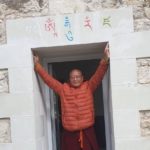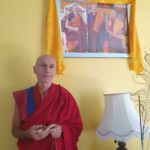Cédric Hubaux is the person who has built Shenten´s infrastructure for the online teachings. He is launching, supervising and troubleshooting all of the streamed teaching sessions. “Especially at the beginning it was quite stressful. Everything was new, the internet at Shenten was very bad, and I had to instruct Khenpo Gelek from a distance on how to do as I could not go there,” he says.
Cédric, do you remember exactly when Shenten started its online teachings?
Just after the first lockdown in France began, in the first half of March 2020. I would say on the 17th March, I would need to check. The first one was Khenpo Gelek’s one hour teaching and practice session which then became the regular and popular “DailyGelek”, and later “DailyShenten”, when other lamas from Shenten started occasionally to take part in it.
DailyShenten accompanied all of us through all those difficult lockdown periods and it was free of charge for the whole first year; Khenpo Gelek taught every day and his sessions were only interrupted when there were other teachings on the program.
People from around the world responded with lots of enthusiasm and support. At the start of those teachings we had close to three hundred attendees for each session, later between one and two hundred people showed up for a session.
Most of us had never heard about zoom until the online teachings started. Did you have an experience with a streaming platform before?
Absolutely not. But I knew that zoom was already being used by some other centers before the covid. Privately people used skype mostly, and messenger, but these two do not allow to organize webinars.
As the situation with the covid worsened in February 2020, the Council of Association Shenten Dargye Ling started to discuss with Khenpo Gelek the possibility to stream teachings from Shenten.
And we agreed finally that we should do it. We collected some info about various platforms existing – it was a very quick search only – and we decided for zoom.
You had to learn quickly how to manage the system…
Yes, I remember that for a few days I was fully immersed in the youtube tutorials, trying to figure out how it all works and how to make it work for our purposes. Translations were a difficult part of it; how to organize them. When we started, people faced some difficulties on how to connect with zoom. All the attendees had to be connected to their own zoom account in order to be able to join the webinar, but many weren´t and just clicked on the link and it did not work. Now it is not necessary anymore to be logged into the account and problems are much less. Sometimes they still happen with the translators.
You have been the main technical support of all the infrastructure for streaming. Is it an enjoyable, or a stressful experience?
Especially at the beginning it was quite stressful. Everything was new, Internet at Shenten was very bad, and I had to instruct Khenpo Gelek from a distance on how to do. I had to install apps on Khenpo´s computer, using a remote control for it. I remembered that there was a webcam somewhere at Shenten but I was not sure where it was, so we were on the phone with Khenpo Gelek and I was guiding him to various places where it could be, until we found it. I was thinking constantly about how to improve this or that. My head was full of ideas, but I was far away, there was a lockdown!
As soon as we were allowed to travel, I went to Shenten to improve things. We added a better mic, a bigger camera. I worked quite hard to put the wifi in important places of Shenten. And later, I think it was just before the third lockdown, I could put the wifi close to the gompa and the streaming was done from the gompa since that time. It was a surprise for people attending and I remember that many were happy to see the gompa.
You were a fan of streaming from the very beginning, right?
Yes, I was in favor of it two years before the covid arrived. The Dutrisu ceremony in 2018 was partially streamed, because I had insisted, it was a kind of test of what could be done with it. I have always liked the idea of giving teachings online and I suggested it a few times to both Khenchen Rinpoche and to Khenpo Gelek. But before the pandemic they both strongly refused. I remember that they were very much against it. Two years later their attitude changed because we were forced by the circumstances. Now I think both of them see advantages of teaching online.
There are advantages but also risks, would you agree?
Actually, I do not see many risks and instead I see many opportunities. What I have seen as a risk was just that many people could connect through one computer and doing so they could watch the teaching for free. And I was also afraid that if we introduced the online teaching, less people would be coming to Shenten physically, and this has happened, we are facing it this year. (Note: for example, Khenpo Tenpa Yungdrung Rinpoche´s teaching held traditionally in April was attended onsite by around 25 people this year, while in the past it was double and more).
With the streaming, more people have access to the teaching for less cost, which is good. On the other hand, there are less opportunities to correct misunderstandings when people listen from their homes, instead of coming physically to a place where there is a community of teachers and practitioners.
For many people coming to Shenten is quite costly. Some could not come even if they wanted to. Now there is a possibility to listen to so many more teachings, compared to the time before. Considering all the factors together, I would say it is better now. But it is a bit weird for me to see Shenten emptier than before, I had got used to lots of movement there, lots of people spending time together. This year, during retreats, Shenten is more quiet.













anne Montange
July 4, 2022 — 5:44 am
Merci pour votre collaboration,votre présence-
María Claudia Garavito
July 3, 2022 — 7:13 pm
My blessings to Cedric. If it was not for him, my practice would not have progressed as it has. Thank you so much!